PUBH6005 Epidemiology Assignment: Research Designs and Findings
VerifiedAdded on 2022/08/31
|6
|1596
|19
Homework Assignment
AI Summary
This document provides a comprehensive solution to an epidemiology assignment, addressing key concepts in public health research. The assignment is divided into two parts. Part 1 analyzes the Whitehall studies, focusing on the prevalence of cardiovascular disease and social determinants of health among British civil servants. It explores the study's methodology, findings, and the generalizability of its results to other populations. Part 2 delves into the selection of appropriate study designs for various health issues, including lung cancer and smoking (meta-analysis), depression and binge eating (randomized control trial), the effects of detention on asylum seekers (cross-sectional study), the relationship between experiences and outcomes (case-control study), and Alzheimer's disease (cohort study). The solution justifies the selection of each study design, providing advantages and disadvantages for each scenario. The document references relevant literature to support the analysis.

Running Head: EPIDEMIOLOGY
EPIDEMIOLOGY
Name of the Student
Name of the University
Author’s Note
EPIDEMIOLOGY
Name of the Student
Name of the University
Author’s Note
Paraphrase This Document
Need a fresh take? Get an instant paraphrase of this document with our AI Paraphraser
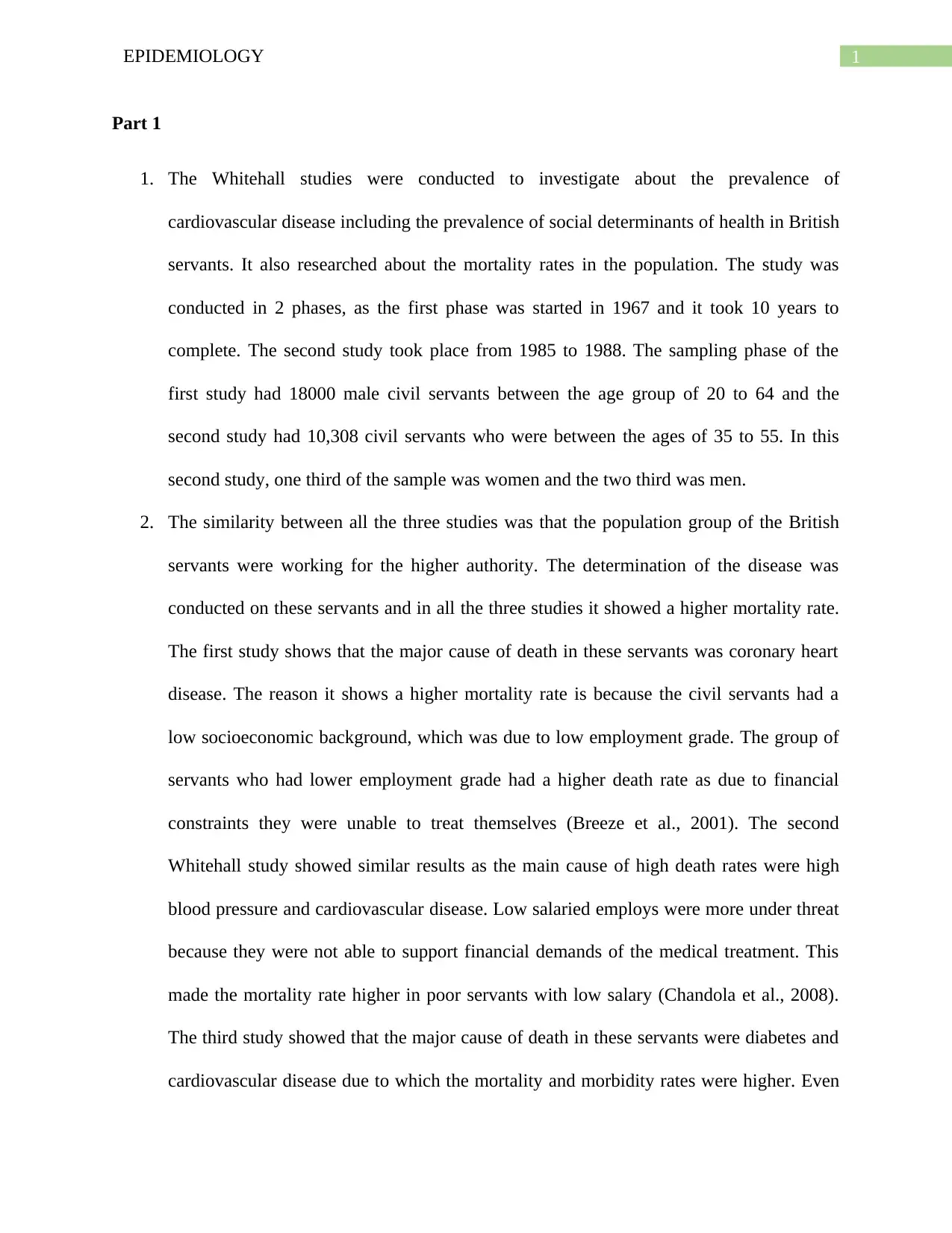
1EPIDEMIOLOGY
Part 1
1. The Whitehall studies were conducted to investigate about the prevalence of
cardiovascular disease including the prevalence of social determinants of health in British
servants. It also researched about the mortality rates in the population. The study was
conducted in 2 phases, as the first phase was started in 1967 and it took 10 years to
complete. The second study took place from 1985 to 1988. The sampling phase of the
first study had 18000 male civil servants between the age group of 20 to 64 and the
second study had 10,308 civil servants who were between the ages of 35 to 55. In this
second study, one third of the sample was women and the two third was men.
2. The similarity between all the three studies was that the population group of the British
servants were working for the higher authority. The determination of the disease was
conducted on these servants and in all the three studies it showed a higher mortality rate.
The first study shows that the major cause of death in these servants was coronary heart
disease. The reason it shows a higher mortality rate is because the civil servants had a
low socioeconomic background, which was due to low employment grade. The group of
servants who had lower employment grade had a higher death rate as due to financial
constraints they were unable to treat themselves (Breeze et al., 2001). The second
Whitehall study showed similar results as the main cause of high death rates were high
blood pressure and cardiovascular disease. Low salaried employs were more under threat
because they were not able to support financial demands of the medical treatment. This
made the mortality rate higher in poor servants with low salary (Chandola et al., 2008).
The third study showed that the major cause of death in these servants were diabetes and
cardiovascular disease due to which the mortality and morbidity rates were higher. Even
Part 1
1. The Whitehall studies were conducted to investigate about the prevalence of
cardiovascular disease including the prevalence of social determinants of health in British
servants. It also researched about the mortality rates in the population. The study was
conducted in 2 phases, as the first phase was started in 1967 and it took 10 years to
complete. The second study took place from 1985 to 1988. The sampling phase of the
first study had 18000 male civil servants between the age group of 20 to 64 and the
second study had 10,308 civil servants who were between the ages of 35 to 55. In this
second study, one third of the sample was women and the two third was men.
2. The similarity between all the three studies was that the population group of the British
servants were working for the higher authority. The determination of the disease was
conducted on these servants and in all the three studies it showed a higher mortality rate.
The first study shows that the major cause of death in these servants was coronary heart
disease. The reason it shows a higher mortality rate is because the civil servants had a
low socioeconomic background, which was due to low employment grade. The group of
servants who had lower employment grade had a higher death rate as due to financial
constraints they were unable to treat themselves (Breeze et al., 2001). The second
Whitehall study showed similar results as the main cause of high death rates were high
blood pressure and cardiovascular disease. Low salaried employs were more under threat
because they were not able to support financial demands of the medical treatment. This
made the mortality rate higher in poor servants with low salary (Chandola et al., 2008).
The third study showed that the major cause of death in these servants were diabetes and
cardiovascular disease due to which the mortality and morbidity rates were higher. Even
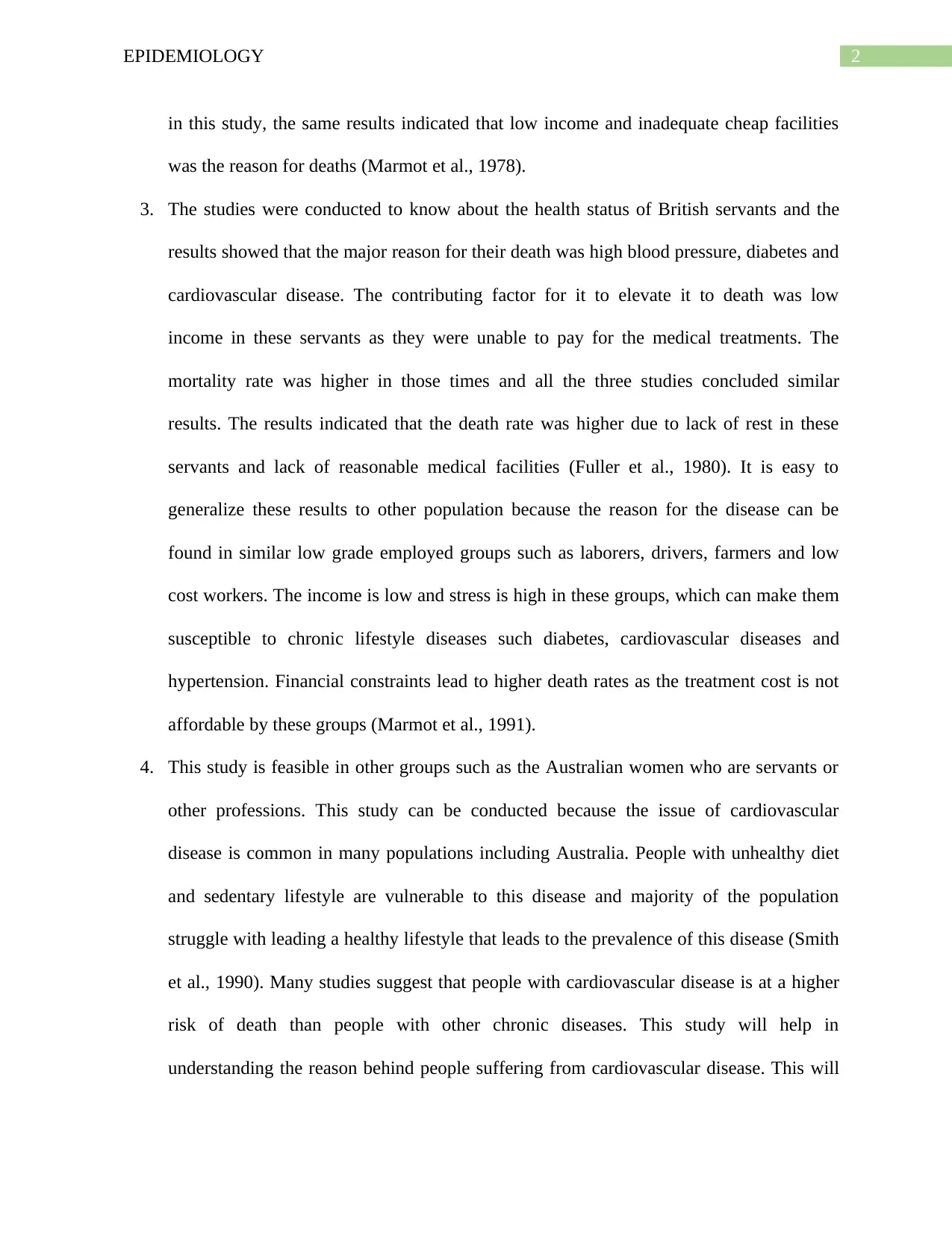
2EPIDEMIOLOGY
in this study, the same results indicated that low income and inadequate cheap facilities
was the reason for deaths (Marmot et al., 1978).
3. The studies were conducted to know about the health status of British servants and the
results showed that the major reason for their death was high blood pressure, diabetes and
cardiovascular disease. The contributing factor for it to elevate it to death was low
income in these servants as they were unable to pay for the medical treatments. The
mortality rate was higher in those times and all the three studies concluded similar
results. The results indicated that the death rate was higher due to lack of rest in these
servants and lack of reasonable medical facilities (Fuller et al., 1980). It is easy to
generalize these results to other population because the reason for the disease can be
found in similar low grade employed groups such as laborers, drivers, farmers and low
cost workers. The income is low and stress is high in these groups, which can make them
susceptible to chronic lifestyle diseases such diabetes, cardiovascular diseases and
hypertension. Financial constraints lead to higher death rates as the treatment cost is not
affordable by these groups (Marmot et al., 1991).
4. This study is feasible in other groups such as the Australian women who are servants or
other professions. This study can be conducted because the issue of cardiovascular
disease is common in many populations including Australia. People with unhealthy diet
and sedentary lifestyle are vulnerable to this disease and majority of the population
struggle with leading a healthy lifestyle that leads to the prevalence of this disease (Smith
et al., 1990). Many studies suggest that people with cardiovascular disease is at a higher
risk of death than people with other chronic diseases. This study will help in
understanding the reason behind people suffering from cardiovascular disease. This will
in this study, the same results indicated that low income and inadequate cheap facilities
was the reason for deaths (Marmot et al., 1978).
3. The studies were conducted to know about the health status of British servants and the
results showed that the major reason for their death was high blood pressure, diabetes and
cardiovascular disease. The contributing factor for it to elevate it to death was low
income in these servants as they were unable to pay for the medical treatments. The
mortality rate was higher in those times and all the three studies concluded similar
results. The results indicated that the death rate was higher due to lack of rest in these
servants and lack of reasonable medical facilities (Fuller et al., 1980). It is easy to
generalize these results to other population because the reason for the disease can be
found in similar low grade employed groups such as laborers, drivers, farmers and low
cost workers. The income is low and stress is high in these groups, which can make them
susceptible to chronic lifestyle diseases such diabetes, cardiovascular diseases and
hypertension. Financial constraints lead to higher death rates as the treatment cost is not
affordable by these groups (Marmot et al., 1991).
4. This study is feasible in other groups such as the Australian women who are servants or
other professions. This study can be conducted because the issue of cardiovascular
disease is common in many populations including Australia. People with unhealthy diet
and sedentary lifestyle are vulnerable to this disease and majority of the population
struggle with leading a healthy lifestyle that leads to the prevalence of this disease (Smith
et al., 1990). Many studies suggest that people with cardiovascular disease is at a higher
risk of death than people with other chronic diseases. This study will help in
understanding the reason behind people suffering from cardiovascular disease. This will
⊘ This is a preview!⊘
Do you want full access?
Subscribe today to unlock all pages.

Trusted by 1+ million students worldwide
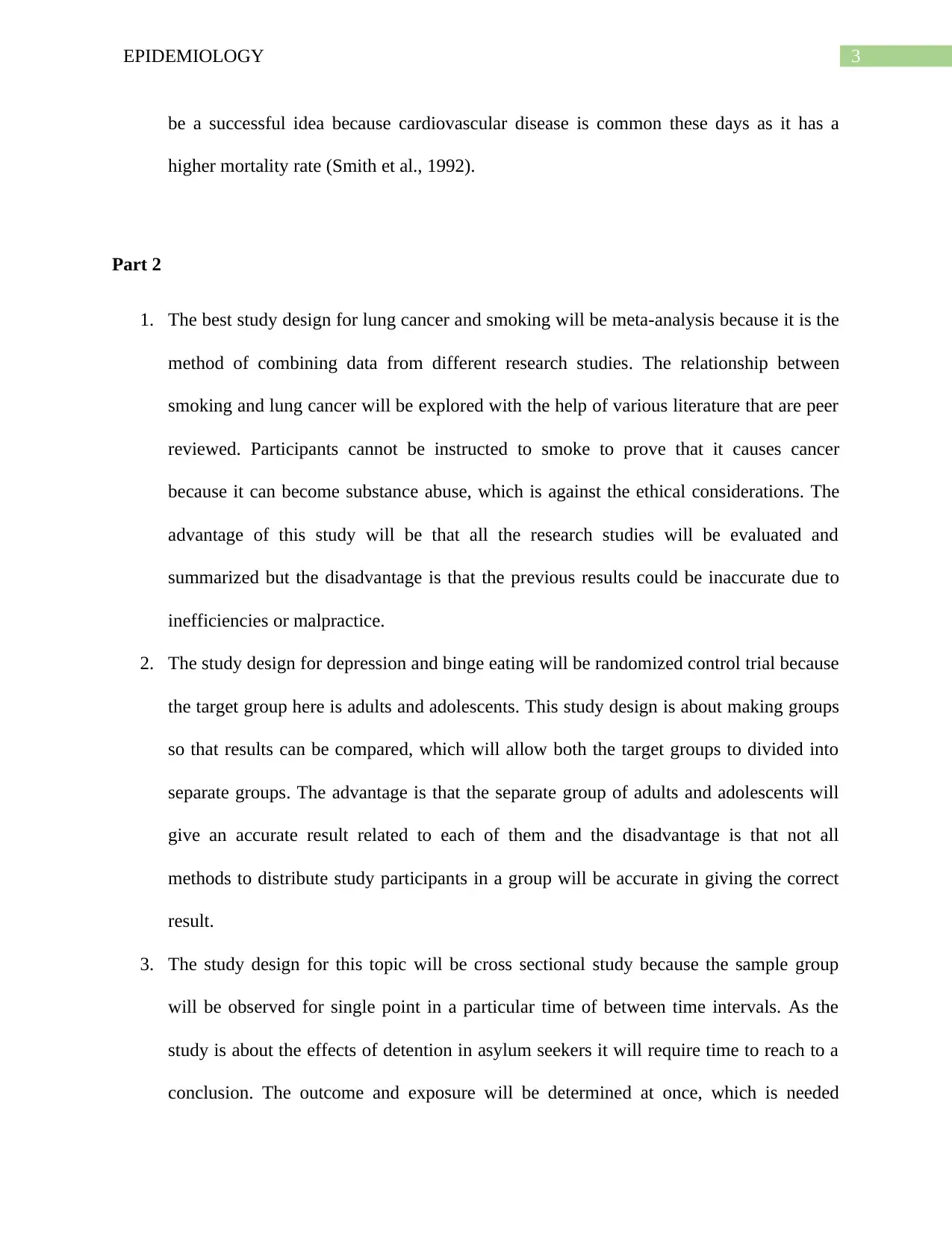
3EPIDEMIOLOGY
be a successful idea because cardiovascular disease is common these days as it has a
higher mortality rate (Smith et al., 1992).
Part 2
1. The best study design for lung cancer and smoking will be meta-analysis because it is the
method of combining data from different research studies. The relationship between
smoking and lung cancer will be explored with the help of various literature that are peer
reviewed. Participants cannot be instructed to smoke to prove that it causes cancer
because it can become substance abuse, which is against the ethical considerations. The
advantage of this study will be that all the research studies will be evaluated and
summarized but the disadvantage is that the previous results could be inaccurate due to
inefficiencies or malpractice.
2. The study design for depression and binge eating will be randomized control trial because
the target group here is adults and adolescents. This study design is about making groups
so that results can be compared, which will allow both the target groups to divided into
separate groups. The advantage is that the separate group of adults and adolescents will
give an accurate result related to each of them and the disadvantage is that not all
methods to distribute study participants in a group will be accurate in giving the correct
result.
3. The study design for this topic will be cross sectional study because the sample group
will be observed for single point in a particular time of between time intervals. As the
study is about the effects of detention in asylum seekers it will require time to reach to a
conclusion. The outcome and exposure will be determined at once, which is needed
be a successful idea because cardiovascular disease is common these days as it has a
higher mortality rate (Smith et al., 1992).
Part 2
1. The best study design for lung cancer and smoking will be meta-analysis because it is the
method of combining data from different research studies. The relationship between
smoking and lung cancer will be explored with the help of various literature that are peer
reviewed. Participants cannot be instructed to smoke to prove that it causes cancer
because it can become substance abuse, which is against the ethical considerations. The
advantage of this study will be that all the research studies will be evaluated and
summarized but the disadvantage is that the previous results could be inaccurate due to
inefficiencies or malpractice.
2. The study design for depression and binge eating will be randomized control trial because
the target group here is adults and adolescents. This study design is about making groups
so that results can be compared, which will allow both the target groups to divided into
separate groups. The advantage is that the separate group of adults and adolescents will
give an accurate result related to each of them and the disadvantage is that not all
methods to distribute study participants in a group will be accurate in giving the correct
result.
3. The study design for this topic will be cross sectional study because the sample group
will be observed for single point in a particular time of between time intervals. As the
study is about the effects of detention in asylum seekers it will require time to reach to a
conclusion. The outcome and exposure will be determined at once, which is needed
Paraphrase This Document
Need a fresh take? Get an instant paraphrase of this document with our AI Paraphraser
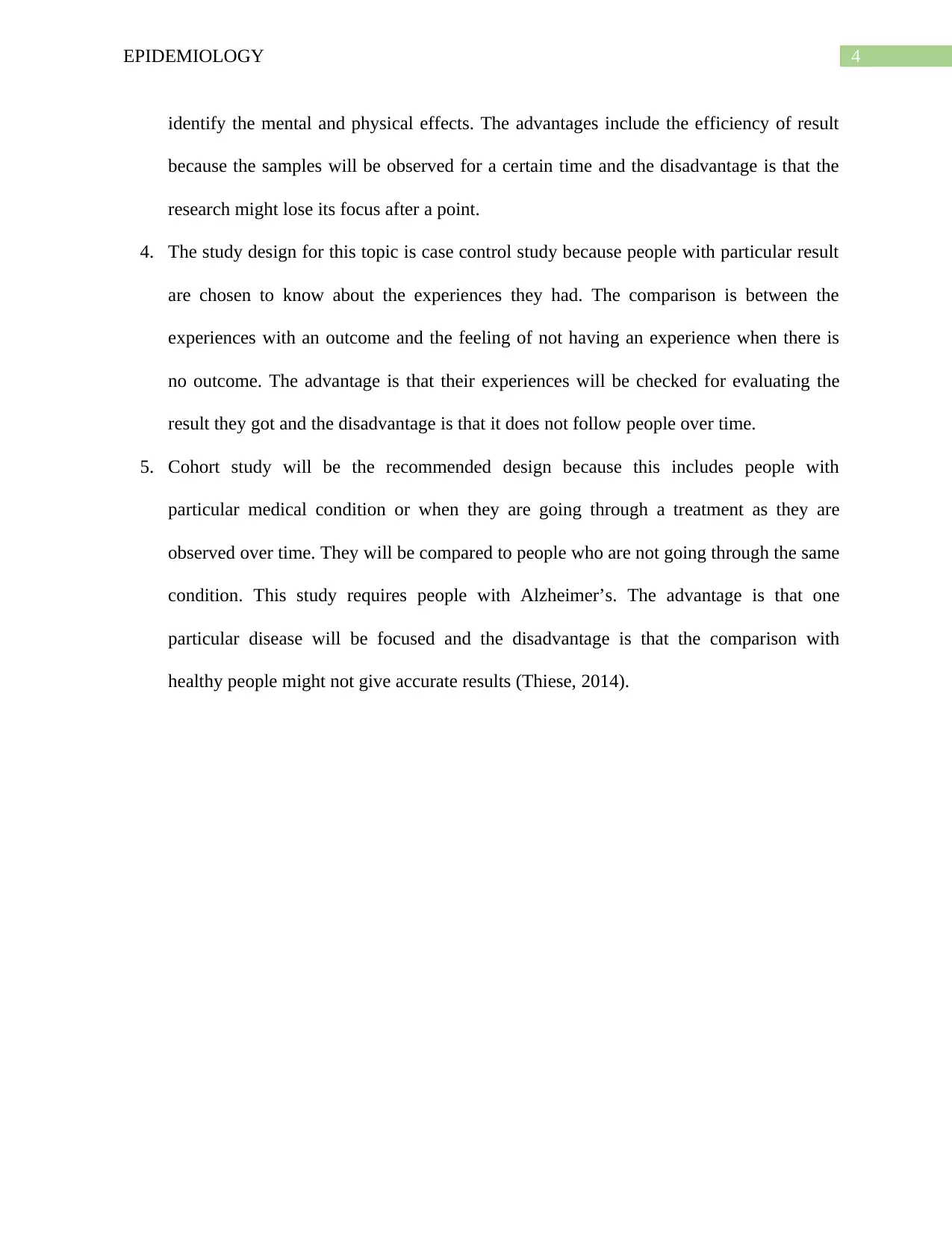
4EPIDEMIOLOGY
identify the mental and physical effects. The advantages include the efficiency of result
because the samples will be observed for a certain time and the disadvantage is that the
research might lose its focus after a point.
4. The study design for this topic is case control study because people with particular result
are chosen to know about the experiences they had. The comparison is between the
experiences with an outcome and the feeling of not having an experience when there is
no outcome. The advantage is that their experiences will be checked for evaluating the
result they got and the disadvantage is that it does not follow people over time.
5. Cohort study will be the recommended design because this includes people with
particular medical condition or when they are going through a treatment as they are
observed over time. They will be compared to people who are not going through the same
condition. This study requires people with Alzheimer’s. The advantage is that one
particular disease will be focused and the disadvantage is that the comparison with
healthy people might not give accurate results (Thiese, 2014).
identify the mental and physical effects. The advantages include the efficiency of result
because the samples will be observed for a certain time and the disadvantage is that the
research might lose its focus after a point.
4. The study design for this topic is case control study because people with particular result
are chosen to know about the experiences they had. The comparison is between the
experiences with an outcome and the feeling of not having an experience when there is
no outcome. The advantage is that their experiences will be checked for evaluating the
result they got and the disadvantage is that it does not follow people over time.
5. Cohort study will be the recommended design because this includes people with
particular medical condition or when they are going through a treatment as they are
observed over time. They will be compared to people who are not going through the same
condition. This study requires people with Alzheimer’s. The advantage is that one
particular disease will be focused and the disadvantage is that the comparison with
healthy people might not give accurate results (Thiese, 2014).
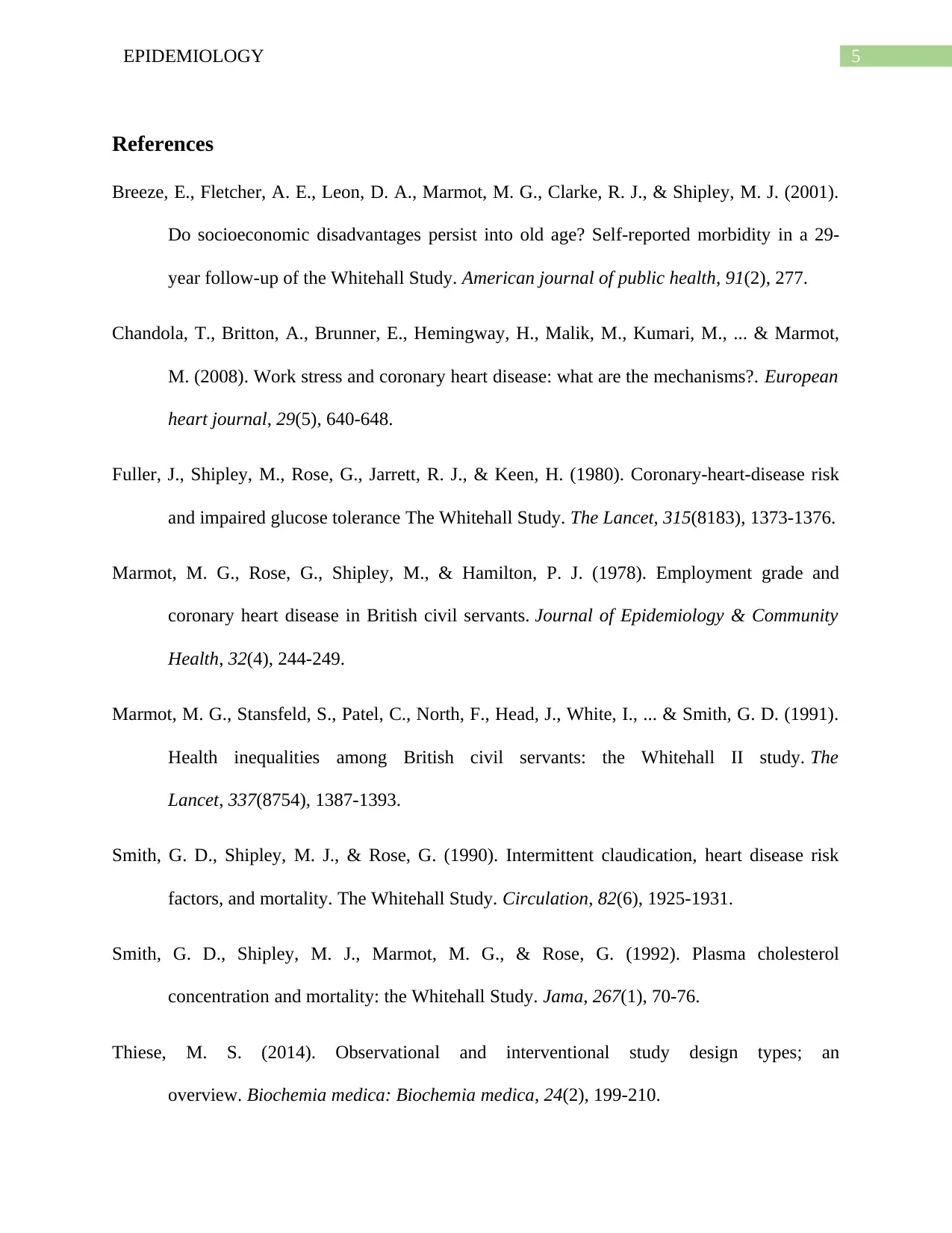
5EPIDEMIOLOGY
References
Breeze, E., Fletcher, A. E., Leon, D. A., Marmot, M. G., Clarke, R. J., & Shipley, M. J. (2001).
Do socioeconomic disadvantages persist into old age? Self-reported morbidity in a 29-
year follow-up of the Whitehall Study. American journal of public health, 91(2), 277.
Chandola, T., Britton, A., Brunner, E., Hemingway, H., Malik, M., Kumari, M., ... & Marmot,
M. (2008). Work stress and coronary heart disease: what are the mechanisms?. European
heart journal, 29(5), 640-648.
Fuller, J., Shipley, M., Rose, G., Jarrett, R. J., & Keen, H. (1980). Coronary-heart-disease risk
and impaired glucose tolerance The Whitehall Study. The Lancet, 315(8183), 1373-1376.
Marmot, M. G., Rose, G., Shipley, M., & Hamilton, P. J. (1978). Employment grade and
coronary heart disease in British civil servants. Journal of Epidemiology & Community
Health, 32(4), 244-249.
Marmot, M. G., Stansfeld, S., Patel, C., North, F., Head, J., White, I., ... & Smith, G. D. (1991).
Health inequalities among British civil servants: the Whitehall II study. The
Lancet, 337(8754), 1387-1393.
Smith, G. D., Shipley, M. J., & Rose, G. (1990). Intermittent claudication, heart disease risk
factors, and mortality. The Whitehall Study. Circulation, 82(6), 1925-1931.
Smith, G. D., Shipley, M. J., Marmot, M. G., & Rose, G. (1992). Plasma cholesterol
concentration and mortality: the Whitehall Study. Jama, 267(1), 70-76.
Thiese, M. S. (2014). Observational and interventional study design types; an
overview. Biochemia medica: Biochemia medica, 24(2), 199-210.
References
Breeze, E., Fletcher, A. E., Leon, D. A., Marmot, M. G., Clarke, R. J., & Shipley, M. J. (2001).
Do socioeconomic disadvantages persist into old age? Self-reported morbidity in a 29-
year follow-up of the Whitehall Study. American journal of public health, 91(2), 277.
Chandola, T., Britton, A., Brunner, E., Hemingway, H., Malik, M., Kumari, M., ... & Marmot,
M. (2008). Work stress and coronary heart disease: what are the mechanisms?. European
heart journal, 29(5), 640-648.
Fuller, J., Shipley, M., Rose, G., Jarrett, R. J., & Keen, H. (1980). Coronary-heart-disease risk
and impaired glucose tolerance The Whitehall Study. The Lancet, 315(8183), 1373-1376.
Marmot, M. G., Rose, G., Shipley, M., & Hamilton, P. J. (1978). Employment grade and
coronary heart disease in British civil servants. Journal of Epidemiology & Community
Health, 32(4), 244-249.
Marmot, M. G., Stansfeld, S., Patel, C., North, F., Head, J., White, I., ... & Smith, G. D. (1991).
Health inequalities among British civil servants: the Whitehall II study. The
Lancet, 337(8754), 1387-1393.
Smith, G. D., Shipley, M. J., & Rose, G. (1990). Intermittent claudication, heart disease risk
factors, and mortality. The Whitehall Study. Circulation, 82(6), 1925-1931.
Smith, G. D., Shipley, M. J., Marmot, M. G., & Rose, G. (1992). Plasma cholesterol
concentration and mortality: the Whitehall Study. Jama, 267(1), 70-76.
Thiese, M. S. (2014). Observational and interventional study design types; an
overview. Biochemia medica: Biochemia medica, 24(2), 199-210.
⊘ This is a preview!⊘
Do you want full access?
Subscribe today to unlock all pages.

Trusted by 1+ million students worldwide
1 out of 6
Related Documents
Your All-in-One AI-Powered Toolkit for Academic Success.
+13062052269
info@desklib.com
Available 24*7 on WhatsApp / Email
![[object Object]](/_next/static/media/star-bottom.7253800d.svg)
Unlock your academic potential
Copyright © 2020–2025 A2Z Services. All Rights Reserved. Developed and managed by ZUCOL.





